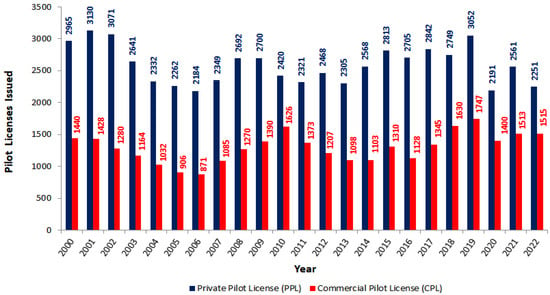Elevated atmospheric reactive nitrogen (Nr) emissions and the subsequent nitrogen (N) deposition have negatively impacted the global environment, particularly in China. In order to assess the long-term trends in atmospheric N deposition in the south of China, Taojiang County in Hunan Province was
[...] Read more.
Elevated atmospheric reactive nitrogen (Nr) emissions and the subsequent nitrogen (N) deposition have negatively impacted the global environment, particularly in China. In order to assess the long-term trends in atmospheric N deposition in the south of China, Taojiang County in Hunan Province was selected as a representative rural area for study. We analyzed interannual variation in atmospheric Nr, including gaseous ammonia (NH
3), nitrogen dioxide (NO
2), nitrate acid (HNO
3) vapor, particulate ammonium (NH
4+), and nitrate (NO
3−) in air and NH
4+-N and NO
3−-N in precipitation from 2011 to 2020. The 10-year average atmospheric wet-plus-dry N deposition was 41.9 kg N ha
−1 yr
−1, which decreased by approximately 24% after 2012, indicating that NH
3 and NO
x emissions were effectively reduced by emission controls introduced in 2013. Wet deposition accounted for approximately 74% of the total N deposition and was significantly influenced by annual precipitation amount. Reduced N (NH
3, pNH
4+, and NH
4+ in rainwater) was the dominant form, comprising approximately 58% of the total N deposition, while oxidized N (pNO
3−, NO
2, HNO
3, and NO
3− in rainwater) accounted for 42% of the total N deposition. Atmospheric HNO
3, NO
2, and NH
3 concentrations and deposition declined by 30–80% over the decade, while particulate NH
4+ and NO
3− concentrations and deposition remained at relatively stable levels, which suggests that ongoing research and policy should focus on rural particulate pollution. Future strategies must concentrate on the integrated control of NH
3 and NO
x emissions to mitigate air pollution and protect human health, particularly in rural areas because current abatement efforts are primarily directed toward urban areas and the industrial sector, whereas non-point source NH
3 pollution, influenced mainly by agricultural activities, dominates in rural regions.
Full article
 IJMS
IMPACT
IJMS
IMPACT Applied Sciences
IMPACT
Applied Sciences
IMPACT Sustainability
IMPACT
Sustainability
IMPACT Sensors
IMPACT
Sensors
IMPACT JCM
IMPACT
JCM
IMPACT Materials
IMPACT
Materials
IMPACT Molecules
IMPACT
Molecules
IMPACT Energies
IMPACT
Energies
IMPACT Electronics
IMPACT
Electronics
IMPACT Remote Sensing
IMPACT
Remote Sensing
IMPACT Cancers
IMPACT
Cancers
IMPACT Nutrients
IMPACT
Nutrients
IMPACT Mathematics
IMPACT
Mathematics
IMPACT Foods
IMPACT
Foods
IMPACT Buildings
IMPACT
Buildings
IMPACT Polymers
IMPACT
Polymers
IMPACT Animals
IMPACT
Animals
IMPACT Water
IMPACT
Water
IMPACT Plants
IMPACT
Plants
IMPACT Agronomy
IMPACT
Agronomy
IMPACT Biomedicines
IMPACT
Biomedicines
IMPACT Processes
IMPACT
Processes
IMPACT Microorganisms
IMPACT
Microorganisms
IMPACT Diagnostics
IMPACT
Diagnostics
IMPACT Nanomaterials
IMPACT
Nanomaterials
IMPACT Viruses
IMPACT
Viruses
IMPACT Medicina
IMPACT
Medicina
IMPACT Healthcare
IMPACT
Healthcare
IMPACT Cells
IMPACT
Cells
IMPACT Forests
IMPACT
Forests
IMPACT Agriculture
IMPACT
Agriculture
IMPACT Land
IMPACT
Land
IMPACT JMSE
IMPACT
JMSE
IMPACT IJERPH
IJERPH
 Symmetry
IMPACT
Symmetry
IMPACT Genes
IMPACT
Genes
IMPACT Pharmaceutics
IMPACT
Pharmaceutics
IMPACT Coatings
IMPACT
Coatings
IMPACT Micromachines
IMPACT
Micromachines
IMPACT Pharmaceuticals
IMPACT
Pharmaceuticals
IMPACT Atmosphere
IMPACT
Atmosphere
IMPACT Children
IMPACT
Children
IMPACT Religions
IMPACT
Religions
IMPACT Antioxidants
IMPACT
Antioxidants
IMPACT Life
IMPACT
Life
IMPACT Metals
IMPACT
Metals
IMPACT Biomolecules
IMPACT
Biomolecules
IMPACT Vaccines
IMPACT
Vaccines
IMPACT Education Sciences
IMPACT
Education Sciences
IMPACT Minerals
IMPACT
Minerals
IMPACT Horticulturae
IMPACT
Horticulturae
IMPACT Brain Sciences
IMPACT
Brain Sciences
IMPACT JPM
IMPACT
JPM
IMPACT Bioengineering
IMPACT
Bioengineering
IMPACT

















